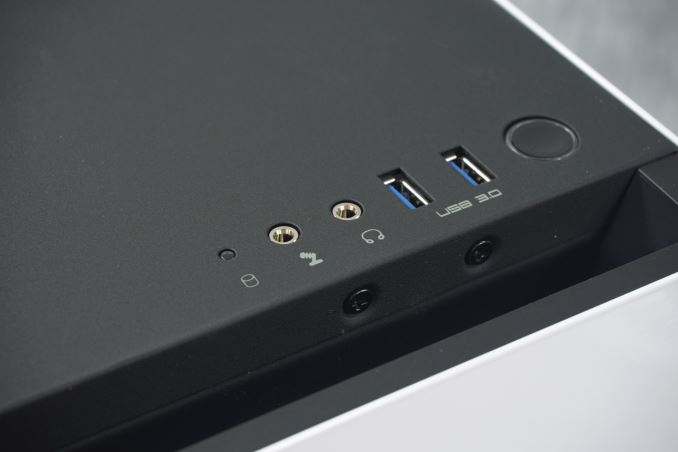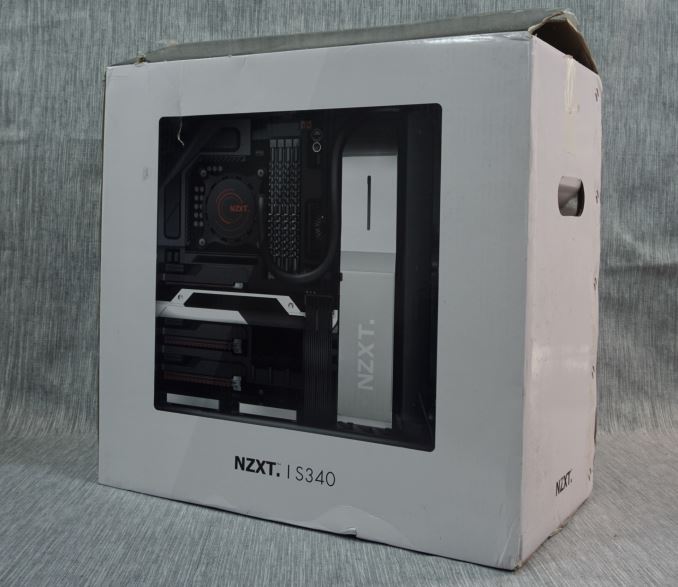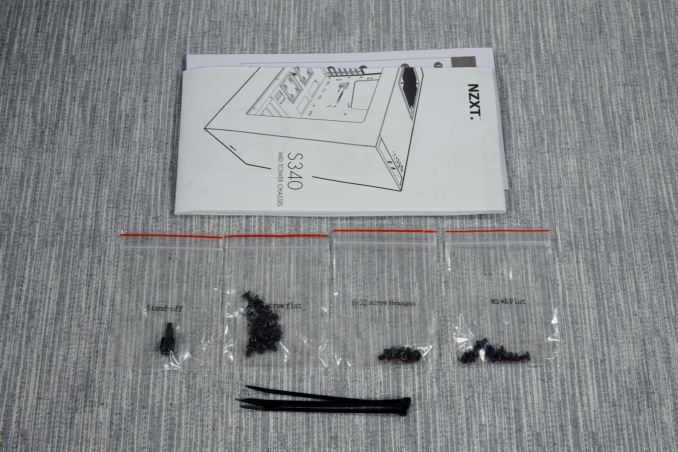The NZXT S340 Case Review
by E. Fylladitakis on July 13, 2015 8:00 AM EST- Posted in
- Cases/Cooling/PSUs
- NZXT
- Case
- ODD-Free

NZXT is a renowned designer of PC cases, offering a wide selection of designs for different tastes and budgets. Even though NZXT has diversified into marketing coolers and PSUs, cases remain the focus of the company, with dozens of designs currently available. Nevertheless, it has been nearly two years since we had a look at any of their newest case designs. In this review, we are going to examine one of their newest products, the S340 in White.
Introduction
The S340 is NZXT’s most recent design and it is taking on a huge bet - to be an entirely metallic case with a price tag of about $80. On paper, the S340 with the MSRP of just $70 has excellent specifications, while it also boasts a metal faceplate and a windowed side panel. It is understood that in order for NZXT to be able to offer all that at such a price, certain sacrifices would have to be made. One of them is the removal of 5.25" bays. "ODD-Free" case designs are becoming more and more common, as the market of optical media is slowly fading and discs are getting closer to meeting the fate of floppy discs and cassettes with each passing day, especially with the price of USB ODD drives being quite low. The lack of ODD support is not the only important thing about the S340 though. We are going to examine NZXT’s latest creation thoroughly in this review.
| NZXT S340 (CA-S340W-W1) | ||
| Motherboard Size | ATX, Micro-ATX, Mini-ITX | |
| Drive Bays | External | - |
| Internal | 2 × 3.5" (internal drive cages) 1 x 3.5" (Bottom frame) 2 × 2.5" (System Area) |
|
| Cooling | Front | 2 × 140 mm or 2 × 120 mm (not included) |
| Rear | 1 × 120 mm (120 mm FN V2 fan included) | |
| Top | 1 × 120 mm or 140 mm (120 mm FN V2 fan included) | |
| HDD | - | |
| Bottom | - | |
| Radiator Support | Front | Up to 280mm |
| Rear | Up to 120mm | |
| Top | - | |
| Side | - | |
| Bottom | - | |
| I/O Port | 2× USB 3.0, 2× USB 2.0, 1× Headphone, 1× Mic | |
| Power Supply Size | ATX | |
| Clearances | HSF | 160 mm |
| PSU | - | |
| GPU | 364 mm (<334 mm if a liquid cooling radiator is installed) | |
| Dimensions | 445 mm × 200 mm × 432 mm 17.52 in × 7.87 in × 17.01 in |
|
| Prominent Features | · 90% Steel Construction · Simple Interior Layout · Compact Size · Kraken™ Ready · ODD Free Design |
|
| Price | $81 incl. shipping | |
Packaging & Bundle
NZXT supplies the S340 in a rather plain cardboard box, with the sole artwork being a picture of an amazingly clean system built inside the black version of the case. The packaging provides ample shipping protection, with thick Styrofoam slabs forming a strong protective shell for the lightweight case.
The bundle of the S340 is spartan, with NZXT providing just the absolute necessary for the assembly of the system. Only a basic manual, black screws and a few short black cable ties are provided.












48 Comments
View All Comments
zepi - Monday, July 13, 2015 - link
Why are these cases so huge in terms of depth? I'd think that removal of 5.25" and 3.5" bays would allow for much more compat case designs.Shadow7037932 - Monday, July 13, 2015 - link
Depth in which direction? If you're talking about making the case thinner sideways, then the reason is because people want to put large tower heatsinks.zepi - Monday, July 13, 2015 - link
Depth in terms of measure from front to back.Shadow7037932 - Monday, July 13, 2015 - link
To fit larger longer GPUs and radiators.mr_tawan - Monday, July 13, 2015 - link
It's for 240mm radiator.Haravikk - Monday, July 13, 2015 - link
Do we really need a 36cm deep case to fit a 240mm radiator? The 90º folds in the chassis should be able to support holes for mounting a radiator, so a depth of 26cm ought to be plenty, for GPU compatibility 30cm probably makes sense (with the PCI brackets extending out the back).I suppose the same question can be asked of why not a Mini ITX motherboard though; it's rare to see anyone actually needing more than one PCIe slot, as IMO it's usually better to just get a single card and upgrade it later, as multi-card setups are almost always disappointing.
I do wish we'd get away from the longer cards actually, as there are too few good half-length offerings, though the 960 from Nvidia and the new Nano from AMD seem like good options. What we really need are more shorter cards with liquid cooling integrated, as it really opens up the possibilities for smaller systems.
niva - Monday, July 13, 2015 - link
Your points are all valid, but in general I feel desktops should keep their size. Laptops and tablets, even cell phones are taking over in terms of compact computing. The charm of the desktop is that it still has the big bays for DVDs and hard drives and giant radiators/fans.Pretty soon we should be able to get rid of the big optical drives though, they're already on the way out. The mass storage devices can be relocated and overall I agree with your suggestions.
I also find multi GPU setups not worth the risk and cost, prefer to get a high end card and keep it for a few years. The large cards are difficult to fit in all cases.
powerwiz - Tuesday, July 14, 2015 - link
What risks are you talking about in terms of mutli GPU set up. Its rather simple and with say the Nvidia 900 series cards your talking about almost half of the power consumption of previous generation cards. I have a MSI 980 GTX SLI set up it was cake to put in. On top of that the cards are near silent in everyday computing. Even with games running max its still pretty quite compared to cards of the past.Also this case was never geared towards you its geared towards a computer enthusiast. I recently built a monster gaming rig using the NZXT H440. While it looks somewhat traditional it lacks all bays for various legacy drives. Internally its been covereted into HDD/SSD slots.
Also if you do not like this case there is a tremendous selection of many other slim cases, micro cases etc.
Kepe - Monday, July 13, 2015 - link
"it's rare to see anyone actually needing more than one PCIe slot"I have a GPU, PCIe SSD and a PCIe sound card. No way I'd manage with just one PCIe slot. Mini ITX lacks expandability. You buy a new Mini ITX system and are happy with it for a while. Then you start thinking about some additions, like a sound card with a headphone amp or a super-fast SSD for games or whatever. Later on your GPU starts lagging behind in the newest games and you think it would be a cheaper upgrade to get a second GPU for SLI on CrossFire. But you can't get anything because your only PCIe slot is taken by the GPU. Mini ITX also lacks the space for M.2 SSDs and often comes with less DDR memory slots than ATX mobos. Even adding memory means you have to buy a new kit with more RAM per stick, instead of just getting two extra sticks to accompany the original ones.
Mini ITX is ok if you want a small, portable system for LAN parties. Also for basic users who don't know anything about upgrading their systems with more stuff. But IMHO, for a "power user" who doesn't want to buy a new system every time he wants to upgrade something, it just isn't enough.
romrunning - Monday, July 13, 2015 - link
You make a bad generalization about mini-ITX cases and the expertise of those who build them. Mini-ITX builders know very well the trade-offs inherent with the smaller footprint. Those storage items you cite (SSD, M.2 SSD) can easily be added to mini-ITX systems, including M.2 as long as the motherboard supports it. Other limitations you quote (2nd GPU, more than two RAM slots) are understood by mini-ITX builders. They also understand you can add external peripherals as well, like an external sound card.When I built my own mini-ITX system, I knew exactly what I wanted. I also knew that if I really wanted to get two GPUs later, I would need a different case. I didn't want a hulking tower case that could fit 3 GPUs and a ton of fans. I was perfectly fine with the GPU I spec'ed out, the SFX PSU needed to support that GPU, the 2 x 8GB DDR, and the SSD I wanted.
If anything, I would say mini-ITX builders have to be more discerning in understanding what they want because of the design constraints of the smaller footprint.